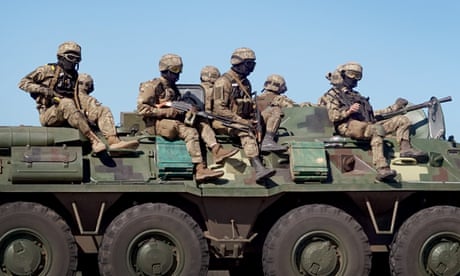- by foxnews
- 08 Apr 2025
Ukraine and Russia ‘compete to be last army standing’ as Donbas deaths mount
Ukraine and Russia ‘compete to be last army standing’ as Donbas deaths mount
- by theguardian
- 09 Jun 2022
- in news

Three and a half months into the Ukraine war and what was once a fight across the whole country feels like it has become concentrated on Sievierodonetsk, the centre of weeks of combat that looks likely to have cost hundreds of lives as Russia appears to be closing in.
Ukrainian insiders estimate that Russia now has 120 battalions inside Ukraine, but such has been the attrition so far, their strength is perhaps 40% or 50% of a normal full complement of about 800. Half that total force is concentrated in the eastern Donbas region - and a third, so 40, around Sievierodonetsk.
It demonstrates the level of concentration Russia needs to make progress, blasting the area with a mix of air, artillery, mortar and even rocket-propelled grenade strikes before advancing over the destruction that remains. All for a city that, while it may be in the frontline, is not militarily strategic.
Ukraine says its goal is simply to hold up the Russians, inflict losses on the larger invading army and reduce their morale. At one point over the weekend the defenders managed a short-lived counterattack, but this seems to have provoked an even more intense bombardment from the invaders.
A similar fight looms for neighbouring Lysychansk across the Siverskyi Donets River that Russian forces have had difficulty crossing. It lies on higher ground than Sievierodonetsk, and is the final city in the Luhansk region held by Ukraine. Ukraine holds more of the neighbouring Donetsk oblast, the other half of the Donbas. Kramatorsk, the most likely final target, is about 40 miles from Lysychansk.
A key question is whether Ukraine can cope with the losses it is sustaining. Estimates vary, but Oleksiy Arestovych, a high-profile Ukrainian military analyst and presidential adviser, said "up to 150 troops a day were being killed and 800 wounded".
That is higher than the 50-100 a day acknowledged by President Volodymyr Zelenskiy, and a high rate of wounded that could reflect poor access to battlefield medicine, or the difficulty of evacuation - or is perhaps an overestimation. But there is also likely to be a similar rate of casualties on the Russian side, amid indications the invading forces are approaching the point of exhaustion.
Olga Oliker, a director from the Crisis Group, an NGO, said that "both sides are competing to be the last army standing", although she believes that Ukraine still has considerable numbers of soldiers available, having "something like doubled" its army size since the war began. So Kyiv can hang on for some while yet.
A potential Russian goal will be to try and secure the Donbas, before perhaps opting for a ceasefire, essentially to hang on to the Ukrainian territory it has gained. The issuing of Russian passports in areas such as Kherson to the south, and more ominously the forced deportations of Ukrainians deemed hostile, indicate its intention to stay.
It is hardly surprising that Zelenskiy said this week that stalemate was not an option for Ukraine, given what is happening in occupied areas. Yet he also conceded in the same interview that "we are inferior in terms of equipment and therefore we are not capable of advancing" unless large amounts of western weaponry arrived.
This may be lobbying but it is also true. Ukraine has only been able to make very limited gains in counterattacks south of Mykolaiv so far. Arestovych suggested Ukraine needed 60 multiple-launch rocket systems, when the US and UK are talking about perhaps a 10th of that, and as many as "600 tanks".
These are large numbers but arguably the reality of what it would take for Ukraine to avoid a stalemate, where Russia runs out of momentum having nevertheless gained most of the south coast and another chunk of the east - and, almost certainly if Vladimir Putin remains in power, with future designs on more.
- by foxnews
- descember 09, 2016
Ancient settlement reveals remains of 1,800-year-old dog, baffling experts: 'Preserved quite well'
Archaeologists have recently unearthed the remarkably well-preserved remains of a dog from ancient Rome, shedding light on the widespread practice of ritual sacrifice in antiquity.
read more


